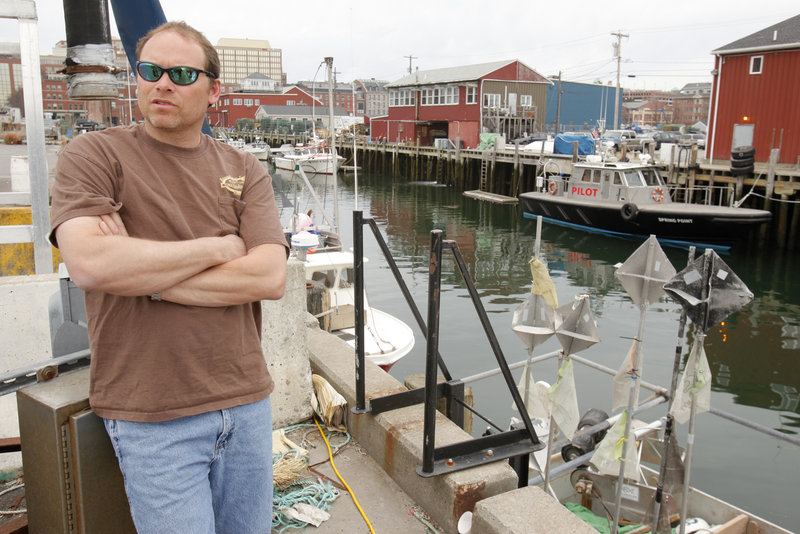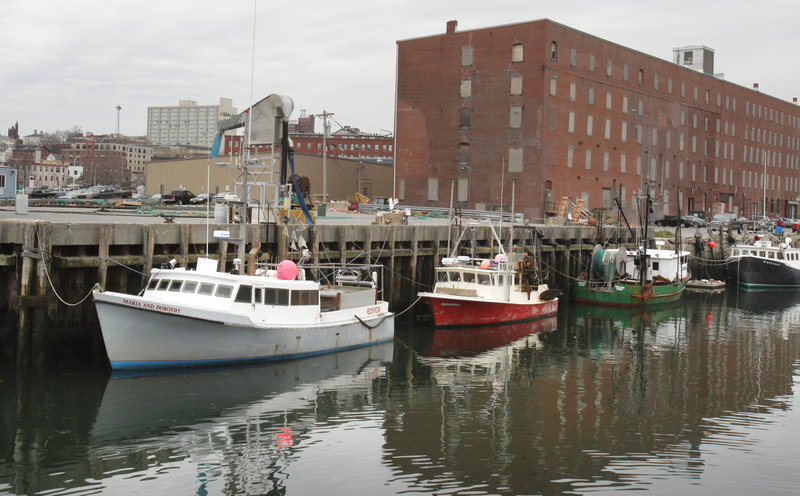PORTLAND — Rob Odlin holds down seven different jobs.
He is a shrimp boat captain, gill net groundfishing boat captain, sea urchin diver, charter boat captain, tuna boat captain, landlord and movie producer.
These days, his movie career is looking the most realistic.
Odlin, 40, says his fishing days may be numbered. He and other groundfishermen are facing major changes in regulations at the end of the month that some estimate will put half of New England’s 1,480-vessel groundfishing fleet out of business.
The regulations encourage fishermen to form into cooperative-like groups, called sectors, which are allocated part of the annual quota for each species. At the same time, the government is setting stiff new quotas for haddock, pollock, flounder, halibut and other groundfish species.
The rules are the latest restrictions placed on the New England groundfishing industry, which has been under pressure to stop overfishing for the past three decades. In the past, fishermen have seen limits placed on the number of days they may fish. They have been told how many fish they may catch on each trip and where they may fish. They have lived through federal boat-buying programs. They have operated with the same number of fishing permits since 1996.
But technological improvements to gear and equipment have allowed fishermen to continue to overfish, according to federal regulators.
Odlin, one of the 65 remaining groundfishermen in Maine, says he fully expects to be among the losers under the new system. But he also vows to go down fighting.
“Of course, I am worried,” said Odlin, who lives in Scarborough.
Like many other fishermen in New England, Odlin takes a dim view of federal regulators’ conclusion that groundfish stocks are still too low and need further protection. Odlin also says the new system has been set up to benefit large, well-financed operations.
“It will make the rich guys richer. How can this be legal?” he asked.
But regulators point out that it was the fishermen who asked for the sector system, though they aren’t required to join one.
Tom Nies, analyst for the New England Fisheries Management Council, said the sectors have a range of small and large operators.
In an effort to be fair, the council made fish allocations for the sectors according to who was catching the fish. So the small inshore boats that land most of the Gulf of Maine cod were allocated more than larger boats that fish offshore and catch fewer cod.
Nies said that it is true that no one knows what will happen once the new system is in place, and it is possible that someone with deep pockets might buy all the quota from members of his sector.
“But he is only going to buy it if someone wants to sell it to him,” said Nies.
Odlin, the youngest of eight children, grew up in a prominent South Portland fishing family. He started fishing as a boy with his father, Arthur.
Three of his five older brothers also fish in New England.
His oldest brother, James, owns Atlantic Trawlers Fishing Inc., operates five fishing boats, including three out of Portland, and sits on the New England Fisheries Management Council. The agency manages fishery resources within the 200-mile federal limit off the New England coast.
Another brother and his wife, Chris and Amanda Odlin of Scarborough, own two fishing boats now based in Boston.
Rob Odlin’s brothers expect to fare well under the new rules.
“We are cautiously optimistic,” said James Odlin.
But Rob Odlin said he is probably doomed, and even his family members agree.
Odlin went to work as a commercial fisherman right out of South Portland High School. Like most fishermen today, he is highly diversified.
For the first 20 years, he concentrated on shrimp and sea urchins. Then five years ago, he branched out into groundfishing, buying a 50-foot boat, the Maria and Dorothy, with a $250,000 mortgage. He paid another $100,000 for a groundfish permit.
“My business plan was to be able to fish and make my payments,” he said.
Odlin fishes with gill nets, a highly efficient fishing technique. On groundfishing days, he would head out 25 to 30 miles with two or three helpers and set three miles of gill net gear, which looks like a series of tennis court nets strung across the ocean floor.
The fish get caught by their gills as they swim through the net. After a few hours, Odlin’s crew hauls up the nets in which the fish have become entangled.
Odlin is a talented groundfisherman. Last year, he pulled in 300,000 pounds of pollock, hake and other species on the 39 days he was allowed under current regulations, and the 60 days he bought from other fishermen for $18,000.
He is among the fishermen who opted not to join one of the sectors. Instead, he decided to fish in what is called the “common pool,” which includes about 665 boats.
Under the new rules about to go into effect, Odlin not only will be reduced to 24 fishing days this year, but he will also be limited to 2,000 pounds of hake, 1,000 pounds of pollock and 800 pounds of cod a day. At that rate, he will be allowed a maximum 91,200 pounds of groundfish under even the best conditions this season.
Odlin, whose wife, Maria, gave birth Friday to their first child, Amelia Catherine, said it has become abundantly clear that the 75 percent of his annual income that comes from groundfishing is about to be greatly reduced. He wonders whether he will be able to recoup the cost of his fishing boat if he is forced to sell.
The problem for Odlin is that under the new system, fishermen are assigned a catch limit based on their annual landings between 1996 and 2006. Because Odlin did not enter the fishery until late in 2005, his limit is much lower than that of fishermen who have a long and successful history, including his brothers James and Chris, who have both joined sectors.
The sectors are assigned a quota based on the members’ fishing history, and each individual member is assigned a share of the catch based on the fishermen’s annual landings between 1996 and 2006. Rob Odlin would have been limited to 12,000 pounds of fish in a sector. So he decided to take his chances with the common pool.
“What choice do I have?” asked Odlin.
But the quota of fish assigned to the common pool is proportionately smaller than that assigned to the sectors. For example, the pool will be allowed less than 4 percent of the annual cod catch, with the rest assigned to the sectors. The new fishing rules run 330 pages and are incredibly complex.
“You have to be a Rhodes scholar to figure it out,” said Odlin.
He said he is angry at the elected officials in Maine, contending they have not fought hard enough for the state’s shrinking groundfishing fleet.
Odlin said his survival plan on May 1 is to fish as intensively and quickly as he can to catch as much of his 91,200-pound limit as possible before the quotas are reached and the fisheries are shut down for the common pool.
He will also try to buy quotas from other fishermen, but whether the prices other fishermen charge will be affordable is far from certain.
Odlin has a fallback plan if his strategy fails.
“Sell everything and move to Panama,” he said.
Staff Writer Beth Quimby can be contacted at 791-6363 or at:
bquimby@pressherald.com
Send questions/comments to the editors.




